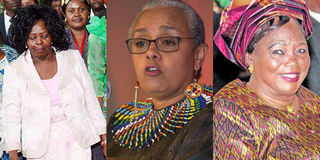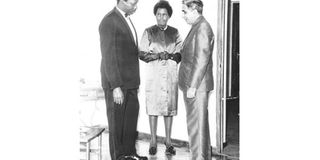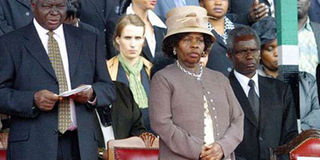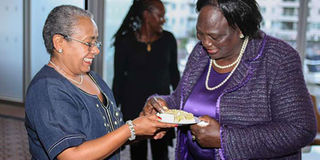Premium
First Ladies, the silent power behind the Presidency

From left: First Ladies, Lucy Kibaki, Margaret Kenyatta and Mama Ngina. PHOTO | FILES
What you need to know:
- Compared to First Lady Mama Ngina Kenyatta, Wahu was unable to immerse herself into the political life of Mzee Kenyatta. It was Ngina who would emerge as the post-independent “Mama wa Taifa” as she was hailed in public.
- The death of Mzee Kenyatta would have seen Kenya get Lena Tungo Moi as its next First Lady. But by 1978, Mr Moi’s marriage had almost collapsed and he was more or less divorced. The official divorce was in 1979.
- In an interview in 1967, Lena Moi said it was necessary that the children were cared for by their own mothers if they were to grow up mentally and physically healthy.
- But Mrs Kibaki asserted herself in public affairs and so has Mrs Kenyatta, who has won the admiration of many with her Beyond Zero campaign
By the time she died in April 2007, Grace Wahu Kenyatta had faded from the public eye.
Although she was President Jomo Kenyatta’s first wife, Wahu did not get into the trappings of power associated with the presidency and opted for a rural lifestyle in Dagoretti where she had brought up her two children – former Nairobi Mayor Margaret Kenyatta and former Juja MP and assistant minister, the late Peter Muigai.
Her burial, unlike that of former First Lady Lucy Kibaki yesterday, was a conventional clergy-driven ceremony. Again, she never got the immense coverage as witnessed after Lucy’s death.
Wahu was different – and during public ceremonies, her headgear and flowing dress stood out as she took her seat on the dais – unperturbed by her place. She had no power-brokers beside her and was at home at her rural Ngando Presbyterian church near Nairobi’s Dagoretti Corner where she worshipped with commoners and tithed like everyone else.
After Mzee Kenyatta’s death in August 1978, Wahu took her seat on the front row during the State burial ceremony but quickly retreated back to Dagoretti to start a private life. That is how she lived.
Compared to First Lady Mama Ngina Kenyatta, Wahu was unable to immerse herself into the political life of Mzee Kenyatta. It was Ngina who would emerge as the post-independent “Mama wa Taifa” as she was hailed in public, becoming one of the most powerful and rich women from the 1960s and 1970s.
Due to her position, Mama Ngina managed to snap several choice properties in the country just as Kenyatta-era power brokers – Mbiyu Koinange, Eliud Mahihu, Eliud Mathu, Njoroge Mungai and others from Kiambu did. But she too was philanthropic and started the Mama Ngina children’s homes and supported several other charity projects.
But in most cases, she was dwarfed by the charisma and near-deity image of her husband, who had emerged from prison with a larger-than-life ego. Mama Ngina had also emerged unscathed from a colonial Kamiti Maximum Mau Mau prison to join the then restricted Mzee Kenyatta in Maralal, a rocky outpost 130 kilometres from Nyahururu. Archived doctor’s reports on the exiled family paints a life of struggle.
DIGNIFIED LADY

Mama Ngina in most cases, she was dwarfed by the charisma and near-deity image of her husband, who had emerged from prison with a larger-than-life ego. PHOTO | FILE
The first president’s death in 1978 saw Mama Ngina leave State House in her late 40s. But she too faded out of political platforms and opted for a private life away from the limelight. While she would religiously emerge every August 22 to commemorate the death of Mzee Kenyatta, she never hard-tackled anyone in public and evaded the limelight.
Those who meet her these days says she comes out as an independent thinker who values dignity.
Former State House Comptroller Franklin Bett and Mr Sharad Rao, the chairman of the Judges and Magistrates Vetting Board, have met Mama Ngina on different occasions.
First encounter
In his early days as President Daniel arap Moi’s State House chief, Mr Bett had to meet Mama Ngina to build a relationship because State House handled all requests from the Kenyatta family to the government.
“She is a very fine and disciplined lady,” Mr Bett told Lifestyle.
Mr Bett recalls that the meetings were brief and cordial; and that she told him she would not always be seeking government help in her matters but, if such an occasion arose, she would send her son Mr Uhuru Kenyatta, now the President.
Mr Rao, who was Deputy Public Prosecutor during the reign of Kenya’s first president, said Mama Ngina’s life story is exemplary.
“She came from a humble background and trained herself to be a very dignified First Lady with a lot of presence,” said Mr Rao, who is the chair of the Muthaiga Residents’ Association, of which Mama Ngina is a member.
Unlike Mama Ngina, Mzee Kenyatta’s British wife Edna Clarke was little known locally. He had met Edna during his second trip to the UK. Here, the man who would become Kenya’s first president had got a job as a nursery worker at A.G. Linfields nurseries in the Thakeham Parish, working in tomato houses.
Because most able men had joined the World War II (1939-1945), rural villages had been left bare of men. As he worked for a Mr Armstrong’s family, Kenyatta became well known in Storrington and girls nicknamed him Jumbo. He was flamboyant, talkative, and sociable.
Many families would welcome him home for a chat and that is how he met Edna, a nursery school teacher whose parents were killed in an air raid in May 1941.
It was to him that the young Edna turned for sympathy and support. Soon, the sympathy grew into love and, within one year, Edna was married to Kenyatta in a wedding ceremony on May 11, 1942. He did not mention he had a wife in Kenya – with two children. On August 11, 1943, their son Peter Magana was born in Worthing Hospital, West Sussex.
DEVOTED TO FAMILY

Lena Tungo Moi as its next First Lady. But by 1978, Mr Moi’s marriage had almost collapsed and he was more or less divorced. The official divorce was in 1979. Lena strode Kenya’s political scene with her visibility as the vice-president’s wife and struck everyone with her beauty. PHOTO | FILE
But Edna would later be left in London as he returned to Kenya to give the political struggle some personal push that culminated in his arrest. Edna, apart from a few family appearances in Kenya, opted to stay in Britain, though his son Magana continued to make many visits to Kenya while working for the BBC.
The death of Mzee Kenyatta would have seen Kenya get Lena Tungo Moi as its next First Lady. But by 1978, Mr Moi’s marriage had almost collapsed and he was more or less divorced. The official divorce was in 1979.
Lena strode Kenya’s political scene with her visibility as the vice-president’s wife and struck everyone with her beauty. The collapse of her marriage in 1974 and divorce in 1979 was a bitter blow to the ardent Christian who had been raised under strict Africa Inland Church (AIC) doctrine.
Lena’s parents, the Paul Bomett family, were pioneer Christians in Eldama Ravine and they respected Moi, the young, tall, handsome and well-mannered orphan boy. That is how he found himself in the Bometts’ home, where he silently admired Helena, the beautiful girl with a round face.
Born in 1926, Lena was also a student at the AIM School in Eldama Ravine before she joined Tenwek Girls’ Boarding School in Kericho. Perhaps because of her Christian devotion and the family troubles, Lena never emerged into the limelight during Moi’s 24-year reign.
“She was an iron lady but with a great sense of humour,” recalled Paul Chemirchir in Moi’s biography, The Making of An African Statesman, by Andrew Morton.
Little is know about Lena. She had abandoned her career as a teacher and immersed herself into bringing up her family, settling down with Mr Moi at Tambach Government School, where his first two children, Jennifer and Jonathan Kipkemboi, were born in 1952 and 1953, respectively.
But things took a new twist for Lena in 1955, when he was appointed to the Legco to replace the inefficient John ole Tameno. Mr Moi first fell out with his in-laws in 1961 when his brother-in-law, Eric Bomett, stood against him as an independent candidate in the General Election. Mr Moi won the seat.
“It was not personal. It was a matter of principle,” Mr Bomett would later say.
In an interview in 1967, Lena said it was necessary that the children were cared for by their own mothers if they were to grow up mentally and physically healthy.
“She is equally assiduous about looking after her husband, who enjoys her cooking and only eats outside the home when he has to,” veteran journalist Faraj Dumila, who conducted the interview, wrote.
Moi bought her a farm in Kabimoi and up to this day, it is not clear why the marriage broke down. In Mr Moi’s authorised biography, The Making of an African Statesman, British author Andrew Morton says Lena refused to dance with Mzee Kenyatta.
“As an uncompromising Christian (Lena) believed that dancing was sinful, but the gesture to the President gravely embarrassed Moi”.
As she faded away, after leaving the vice-president’s official residence at Nairobi’s Kabarnet Gardens, Lena missed church weddings of her children, an indicator of the big divide between her and President Moi.
FORMIDABLE WOMAN

President Mwai Kibaki, his wife Lucy Kibaki. Lucy had quit her teaching career after Mr Kibaki won the Doonholm parliamentary seat and carried on with family business as she raised the young family. PHOTO | AFP
That could explain why in August 1982, when rebel soldiers from the Kenya Air Force announced that they had deposed the President, an attempt by Moi’s bodyguards to evacuate her from Kabimoi to a more secure place was met with a solid “No”.
Mr Rao met Lena on various occasions when Mr Moi was vice-president and he holds her in high regard.
“She was very well-spoken and social. I regret very much the falling-out as she would have supported President Moi very ably,” said Mr Rao.
At Kabimoi ranch in Baringo, like Wahu Kenyatta, she immersed herself into rural life until her death.
While it was initially thought she would be buried there, there was a last minute change and she was interred in President Moi’s Kabarak farm near Nakuru.
First Lady Lucy Kibaki who died last week was eulogised as “different … a defender of her family.”
Mr Isaiya Kabira, the head of the Presidential Press Service during Mr Kibaki’s reign, told the Nation recently that Lucy was a steadfast woman.
“She was a formidable adviser, playing the role of enforcer of what she believed to be the core values of both the Kibaki presidency and Mwai Kibaki the person,” he said.
Lucy had quit her teaching career after Mr Kibaki won the Doonholm parliamentary seat and carried on with family business as she raised the young family.
For many years, Lucy was not known until she emerged after the formation of the Democratic Party (DP) and was involved in Kibaki’s presidential campaigns.
During the NARC party campaigns iin 2002, Lucy played a pivotal role and took her place as First Lady after her husband won the presidency. The office of the First Lady was created, giving it some official status.
While close friends of President Kibaki described Lucy as the bedrock of his political career, she was a pain to those who crossed her path inside State House and within the government. Deputy President William Ruto admitted as much when he eulogised her.
After Mr Kibaki’s 10-year rule, President Uhuru Kenyatta took over the seat left by his father 35 years earlier. His wife Margaret needs no introduction as she has been making headlines for her involvement in Beyond Zero, a project to reduce maternal deaths.
“She has contributed so significantly to various causes and she makes us proud,” said Mr Rao.
First Ladies, Mr Bett explained, add “flavour and salt” to their men.
AGENDA SETTING

First Lady Margaret Kenyatta serves a piece of cake to former First Lady Mama Ngina Kenyatta who is also her Mother-in-Law during her 50th birthday celebrations at a cocktail party in London. PHOTO | PSCU
“A wife is useful because she has that extra sense that views complex issues in a different way from men. Ladies have an extra ear. They get to understand the extra issues that are not said and give that important extra opinion,” he said.
Margaret has given the office of the First Lady some new meaning. She hardly engages in fights with politicos and is at home with both opposition and government figures. When the history of First Ladies is written, perhaps she will win many accolades.
Analysing the place of First Ladies in Kenyan history, political scientist Winnie Mitullah says Margaret is the one who has drawn the most attention to the role of the President’s wife.
Prof Mitullah, who heads the Institute for Development Studies at the University of Nairobi, says Margaret’s mother-in-law, Mama Ngina, was a First Lady at a time when her position was not given much consideration.
“Mama Ngina, of course, joined Mzee Kenyatta on many errands. She was a First Lady in the traditional sense; viewed as somebody who is on your left or your right,” said Prof Mitullah, who was a second year student at the University of Nairobi when Mzee Kenyatta died.
“They could go and represent the President may be in some fundraising or at some function. But I didn’t take that as a serious task as such. When one sets an agenda the way Margaret has done, it’s quite something. It’s something that is unique,” Prof Mitullah added.
She believes the late Lucy tried to create space for the First Lady but her aggressive nature overshadowed her good deeds.
“She was also trying to create space like Margaret. She was not very different from Margaret, but because she had this chequered mixed character … being aggressive overshadowed that,” said Prof Mitullah.
“We cannot take her establishment of the State House Choir for granted. She had an office, she had managers definitely. She had other agenda that she was trying to pursue,” said the scholar.
The scholar believes the current First Lady is doing much better because she is not controversial.
“She is sticking to her agenda, not crossing paths with politicians or with the media as such — if anything she’s only a darling of the media because of her work, promoting her Beyond Zero programme,” she said.
Prof Mitullah hailed the initiative by First Ladies across Africa, who have formed an association.
“There is quite a move towards them having an agenda; and the current First Lady has quite a remarkable space in respect to setting her own agenda and her own character,” she said.





